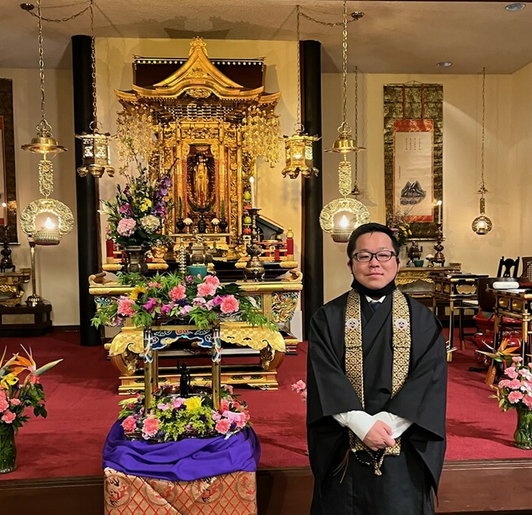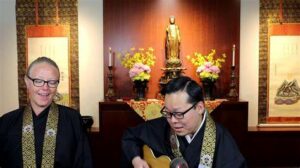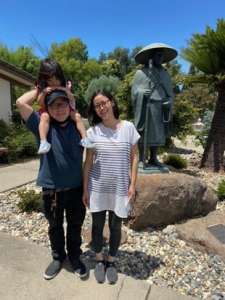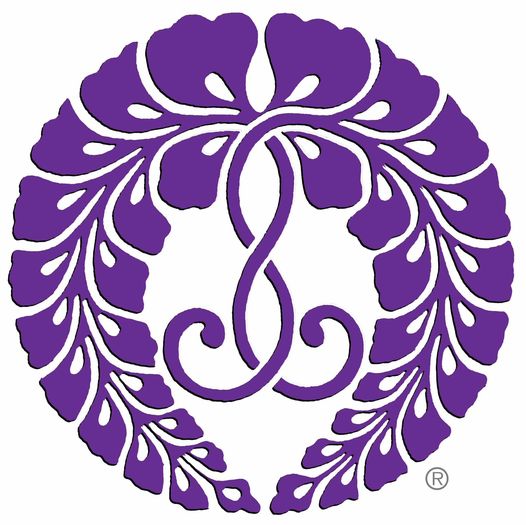
Our Minister
Reverend Noritaka Imada
Reverend Noritaka Imada

Reverend Noritaka Imada, who transferred from the Tri-State/Denver Buddhist Temple to the Northern California District, became our resident minister in August of 2022. The Buddhist Church of Florin will be sharing his ministerial services with the Buddhist Church of Lodi.
He is married to Michele Tiemi. She speaks Japanese, Portuguese and English. She loves to dance and used to practice Belly dancing.
They have a daughter Emma who was born in Tokyo. She loves to play in the park and sing songs. Loves to eat udon and anything sweet.


Reverend Imada was born in Hiroshima, Japan. He studied Buddhism at the Otani University from 2009 to 2013. He then attended the Chuo Bukkyo Gakuin in 2013 to 2014 where he received his certification of Tokudo/Kyoshi. He studied English at the Embassy English Long Beach after working as a Buddhist minister in the Jokyoji Buddhist Temple in Hiroshima. In 2018 he participated in the BCA IMOP (International Ministers Overseas Program). Worked as a temporary English guide staff at the Tsukiji Hongwanji Buddhist Temple in Tokyo before being assigned to the Tri-State/Denver Buddhist Temple in 2019 as BCA minister.
Minister’s Blog
Monthly Message and Quiz

Hello everyone, October has arrived!
A question for everyone. Do you remember what you ate last night? If I were suddenly asked such a question, I would have to think for a while before I could respond. I’m sure I ate something delicious, but what on earth did I eat? I just couldn’t remember, and I had to look in the refrigerator to see the leftovers from last night. We eat meals every day and enjoy every meal but often we forget about it right away. Rennyo Shonin taught us that this is the same with Dharma. He said that even if you listen to the Buddha Dharma and think they are precious and grateful at the time, after a few days, you forget about them. It’s like scooping water with a sieve. If that’s the case, you just need to keep the sieve under water. In other words, he taught us that we should always be in Dharma.
If you look at the Onaijin you will find some food. In Buddhist churches, we offer manju, fruits, or rice in front of the Buddha. These are collected after the service and eaten with gratitude. We offer food during the service to remind ourselves to be grateful for the food.
This month I would like to share a Rakugo story with you. The title is “I’m afraid of manju.” Manju is a steamed bun stuffed with sweet bean paste and it is sometimes offered in front of the Buddha in Buddhist churches. This story is set in Japan during the Edo period (1603 – 1868). In the Edo period, there wasn’t much entertainment like there is today, so it seems that getting together and talking was also a form of entertainment.
One day, young people from the town gathered and talked about things they were afraid of or disliked. Everyone was talking about how they were afraid of spiders and snakes, but one man was completely silent. When asked what he was afraid of, he answered “Nothing.” When asked “What about snakes?” he replied, “I wrap those around my head when I have a headache, like a headband. They keep my head tight and it feels good.” When asked “What about ants?” He replied, “I sprinkle them on the rice instead of Furikake.” He kept saying things like this and it annoyed everyone. Then they asked, him “Isn’t there at least one thing you cannot eat?” When everyone asked this questioned, the man finally thought of something and shouted out, “I’m afraid of manju.” Everyone burst out laughing at what he said, and the man said, “That’s why I didn’t want to tell you. Just the thought of it makes me sick.” Then the man said,” I’m going to lie down in the next room for a bit,” and left for the next room. The other men decided to play a prank on the arrogant man, so they split up and gathered a lot of manju from a sweets shop. Thinking, the man might get scared and die, they threw the manju into the next room and closed the sliding door to prevent the man from escaping. The man who was lying down covered himself with the futon and said, “Wow, manju! It’s scary.” The men were pleased that he was scared. Then the man said, “Wow, manju! The sweet bean paste is scary. This one is a chestnut manju. The big chestnut is scary. This one is sake manju. It smells of sake and it’s scary.” The men around him finally noticed that something was wrong. When they opened the sliding door next to them, they found the man eating the manju with gusto. The people around them thought they had been tricked and said, “Stop eating! What are you really scared of?” to which the man replied, “Well… now, I’m afraid of hot tea.” The man had anticipated that if he said he was afraid of manju, they would bring him manju, and his plan worked, resulting in the young town people being fooled as the man enjoyed plenty of their favorite manju.
Last month’s quiz answers
In Japanese, what do you say to someone who has just returned home? (Welcome back)
1. Itadakimasu 2. Ittekimasu 3. Tadaima 4.Okaeri
Okaeri (Welcome back)
When you leave the house, you say “Ittekimasu (I’m leaving.)” and when you come back you say
“Tadaima (I’m home.)”.
The next quiz

What do you say when you answer the phone?
1. mada mada 2. dame dame 3. Soro soro 4. moshi moshi
In Gassho,
Rev. Noritaka Imada
If you need to contact Rev. Imada, you can email him at: imadabca@gmail.com



In Gassho,
Rev. Noritaka Imada
If you need to contact Rev. Imada, you can email him at: imadabca@gmail.com

Hanasu
There are two Japanese verbs:「話す(talk)」「放す(let go)」
Both of these verbs are pronounced “HANASU”. Talking and letting something go seem different, but they are actually connected. My friend, who is a counselor, said that “talking” to someone also means “letting go” of something inside of us. After we confide our worries to someone, we feel a little more at ease and have more space in our minds. If we can gain space in our minds, we may be able to receive new things and have the desire to try new things. It’s just like when you have a lot of things in your hands, you can’t receive anything. In this way, it seems that letting go is very important. In Buddhism, there is a word called “attachment,” and it is the idea that you should let go.
There is a story about a person named Genza who is called a “Myo-ko-nin.” (“Myo-ko-nin.” is the name given to people who are happier than others to encounter Buddhism in their lives and live with the Nembutsu.) One of the “Myo-ko-nin” was a man called Genza who was a member of the Jodo Shinshu sect. Genza had a cow and walked with it. He had a lot of luggage in his hands. He also had some luggage on the cow’s back. When Genza got tired of walking, he put everything he had in his hands on the cow’s back. At that moment, when he saw the cow continue to walk without slowing down, he noticed something. The luggage that he felt was too heavy for a human being was nothing to the cow. At that moment, he realized the importance of relying on others and the limitations of self- reliance.
Buddha tells us that “attachment is something that should be let go,” but our desire to not let go of our family, our house, our money, and everything else does not disappear. It may be important to learn that Our life is precious and wonderful because you are alive now, rather than worrying about losing the temporary illusions that surround you, because the treasures around you will one day be let go.
I have heard two interesting questions. If the question was, “Would you accept ten million dollars?” I think most people would have no reason to refuse. However, if the question was, “Would you accept ten million dollars if you could die tomorrow instead?”, more people would not accept it. This means that tomorrow is worth more than ten million dollars. We are surrounded by many things we do not want to let go of, but we are blessed to receive the life that we do not want to let go of the most every day.

Last month’s quiz answers
Which quintessentially Japanese dish actually originates from Portugal?
1. Sushi 2. Okonomiyaki 3. Ramen 4. Tempura
Answer: Tempura
The word tempura is said to come from the Portuguese word tempero, which means to cook. There are other theories, such as that it comes from the Spanish word tempuro (temple). Or there is also a theory that it is a phonetic reading of Abura, which means oil, written as
天(Ama)麩(Fu/Pu)羅(La).
The next quiz

Gengō – Era names in Japan
A Japanese era name is a title used for numbering years in the Japanese calendar system. For example, 2018 was Heisei 30.
From the Meiji period onward, it became the rule to change era names only when a new emperor acceded to the throne. Until then, era names were often changed to drive away bad luck and to signal a fresh start after natural disasters. Your era name, and the era names of your parents and grandparents may all be different.
Let’s try to sort the era names correctly in chronological order!
大正(Taishō)江戸(Edo)平成(Heisei)
昭和(Shōwa)令和(Reiwa)明治(Meiji)
In Gassho,
Rev. Noritaka Imada
If you need to contact Rev. Imada, you can email him at: imadabca@gmail.com

OBON

Hello everyone! Obon season is here. Obon is a day to remember our ancestors and Dharma friends who were born into the Pure Land. It is also a day to reconfirm and rejoice that we will someday meet again in the Pure Land.
At Jodo Shinshu temples in Hiroshima, Japan, if you visit the graves during the Obon season, you will find the graves colorfully decorated with paper decorations called Tōrō. Its origin dates back to the Edo period. According to one theory, when a mother loses a child, she makes colorful hand decorations and places them on the child’s grave. In the picture above, you see the colorful Tōrōs, and a grave surrounded by pure white Tōrōs. The grave with the pure white Tōrōs signifies that it is that person’s Hatsubon and was born into the Pure Land less than a year ago.
People who visit the graves write their names on a Tōrō so that the bereaved will know who visited the gravesite. When visiting the graves, we remember the deceased by cleaning the gravestone, offering flowers, and chanting sutras. The utras are the teachings of the Buddha and are messages to all living people. Because, the Buddha’s concern is for us, those who are living in this limited world, rather than those who have already been born into the Pure Land and became Buddhas.
During this Obon season, we remember those who were born into the Pure Land, and this gives us the opportunity to hear the teachings of Buddhism.
Japanese gravestones often have the words “KU E ISSHO” written on them, which means “We will meet again in one place.” We are living a limited life and one day we will have to let go of everything and leave this world. But that is not the end because there is a place called the Pure Land where we can meet again. Knowing this, is the joy of Nembutsu followers.
The Gatha, Shinshu Shuka’s lyrics express the joy of having encountered the teachings of the Nembutsu and gratitude for the infinite wisdom and compassion of Amida Buddha
“Amida you speak to me in teachings profound!
What happiness you bring to me beyond all compare!
I truly seek to follow the way you’ve laid for us,
And gratefully rejoice in your infinite embrace.” Shinshu Anthem

Last month’s quiz answers
What is the popular food to eat on Christmas eve in Japan?
- KFC 🍗
- McDonald’s 🍔
- Dunkin Donut 🍩
The answer is KFC. I think this is because of the impact of the company’s advertising which makes December a very busy season for KFC in Japan.
The next quiz
Which quintessentially Japanese dish originates from Portugal?
1. Sushi 2. Okonomiyaki 3. Ramen 4. Tempura
In Gassho,
Rev. Noritaka Imada
If you need to contact Rev. Imada, you can email him at: imadabca@gmail.com

The Samurai, Naozane Kumagai
Shinran Shonin was perhaps one of Honen Shonin’s most documented disciples. I would like to share a story of one of Honen Shonin’s other disciples this month. This disciple was a famous soldier named Naozane Kumagai who served the Genji Clan during the Heian period of Japanese history. During the Genpei War, one of the enemy soldiers Naozane fought and killed was of the same age as his son. He was shocked and felt the impermanence of life. After that, he decided to become a Buddhist. Naozane asked Honen Shonin, “I killed a lot of people. But if it is possible, I would like to be born into the Pure Land. If I need to kill myself with a sword to be born into the Pure Land, I am determined to do that.” Honen Shonin replied, “You don’t have to kill yourself. Just recite the Nembutsu and you can be born into the Pure Land.” It was at that moment Naozane encountered the Nembutsu teaching and became Honen Shonin’s disciple.
”Just recite the Nembutsu” was the answer from Honen Shonin and his Nembutsu teaching. “Although I am without shame and self-reproach. And lack a mind of truth and sincerity, Because the Name is directed by Amida, its virtues fill the ten quarters. “(Shinran Shonin – Wasan)
In this finite world, with our unstoppable blind passion, we have nothing that will help us reach the Pure Land, but Amida Buddha is trying to help us. Reciting the Nembutsu is not a condition for reaching the Pure Land, but a means to express gratitude for Amida’s work. There is no quota for how many times we have to recite the Nembutsu. We can recite it as much as we want every time we feel grateful. After meeting Honen Shonin, many people’s lives changed and Shinran Shonin is also one of them. Shinran Shonin encountered a lot people in his life, but in particular, his encounter with Honen Shonin seemed important to him. In Kyogyoshinsho, Shinran Shonin wrote about Honen Shonin. His words indicate that his encounter and separation from Honen Shonin were the greatest joy and greatest sadness of his life. Shinran Shonin writes in the last part of Kyogyoshinsho:
” I have collected true words so that they may help others practice the way for birth. For my wish is that those who have attained birth may lead those who come after them and those who aspire for birth may follow their predecessors, thus following one after another endlessly and uninterruptedly until the boundless sea of birth and death is exhausted. “(Shinran Shonin – Kyogyoshinsho)
As for the phrase “the boundless sea of birth and death,” Shinran Shonin often compares Blind Passion with the Sea and Amida’s Vow with the Ship. When Shinran Shonin met Honen Shonin and encountered the path of Nembutsu, he wanted to share the teachings of Nembutsu with people born in the future. Blind passion constantly bubbles up in the heart, however the desire to be born in the Pure Land does not arise. Fortunately, that is proof that you are the target of Amida Buddha’s vow.
“The ocean of birth-and-death, of painful existence, has no bound; Only by the ship of Amida’s universal Vow. Can we, who have long been drowning, Unfailingly be brought across it.” (Shinran Shonin – Wasan)

Last month’s quiz answers
Tonkatsu and Tonkotsu are both Japanese cuisine names.
Tonkotsu [Pork-bone based soup ramen] Tonkatsu [Pork cutlet]
”Ton” means pork, “Katsu” means cutlet, and “Kotsu” means bone. I often hear the word Tonkotsu Ramen, but I don’t often hear the word Tonkatsu Ramen. They have similar pronunciations but different meanings. 🐷
The next quiz
What is the popular food to eat on Christmas eve in Japan?
- KFC 🍗
- McDonald’s 🍔
- Dunkin Donuts 🍩
In Gassho,
Rev. Noritaka Imada
If you need to contact Rev. Imada, you can email him at: imadabca@gmail.com

Gotanye

Happy Spring! I hope you are all enjoying the beautiful weather.
Last month, HanaMatsuri was held, and we were surrounded by beautiful flowers and poured sweet tea on a statue of the baby Shakyamuni Buddha. We celebrated the birth of Buddha Shakyamuni and had a delicious potluck lunch. Thank you to everyone who made this service a success.
In the afternoon, Pickleball was held at the gym and about 10 people participated. We started with a light warm-up such as stretching our muscles, practiced, and played several games with different teams. I felt that everyone could enjoy it, including those with experience and beginners. We look forward to your participation.
Gōtanye, the birthday commemoration of Shinran Shonin, is scheduled for May 12th from 10am. Our founder, Shinran Shonin, was born on May 21, 1173. The Nishi Honganji Temple has held services on this day since 1874, calling it ‘’Gōtanye.’’
Shinran Shonin was born in Kyoto. His father was Arinori Hino. One of Shinran Shonin’s famous stories is about when he became a monk. This story takes place when Shinran Shonin was only 9 years old. He decided to become a Buddhist monk and went to a monk named Jien. However, by the time he arrived there, it was already night, so Jien said, “Tomorrow morning, I will hold the Tokudo ceremony for you.” Tokudo is a ritual to become a monk.
However, Shinran Shonin replied, “I can’t wait until tomorrow.” Then he read the following poem:
”Asu Arito Omou Kokoro No Adazakura, Yowa Ni Arashi no Fukanu Monokaha”
The meaning of this poem is “Cherry blossoms may be blooming beautifully here tonight, but if you take it for granted that you’ll be able to see them again tomorrow, a strong wind may blow in the middle of the night and blow them away.”
He compared his life to cherry blossoms, expressing his feelings, “I don’t know if I’ll have a life tomorrow, so I want to live my life to the fullest.”
Beautiful cherry blossoms were blooming at the Buddhist Church in Florin. The petals were starting to fall, and now you can see the green leaves. No matter how beautiful the cherry blossoms are, they must someday fall. And, the same goes for human life. This is the famous story in which, at just 9 years old, Shinran Shonin felt the impermanence of the world.
Last month’s quiz answers

What is the most common surname in Japan?
”Tanaka, Suzuki, Sato, Toyota”
The most common surname in Japan is Sato. It is said that there are 2 million people with that last name. Suzuki seems to have the second most and Tanaka the fourth.

Tonkatsu and Tonkotsu are both Japanese cuisine names.
Please choose the English translation from 1 and 2 and fill in the blanks below.
Tonkotsu [__________]
Tonkatsu [__________]
- Pork cutlet.
- Pork-bone based soup ramen
In Gassho,
Rev. Noritaka Imada
If you need to contact Rev. Imada, you can email him at: imadabca@gmail.com

